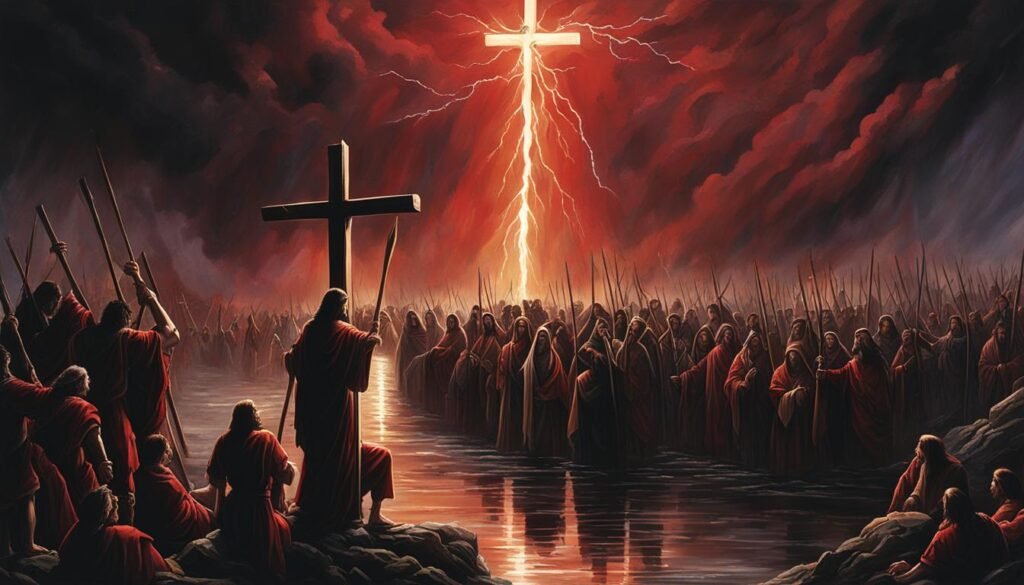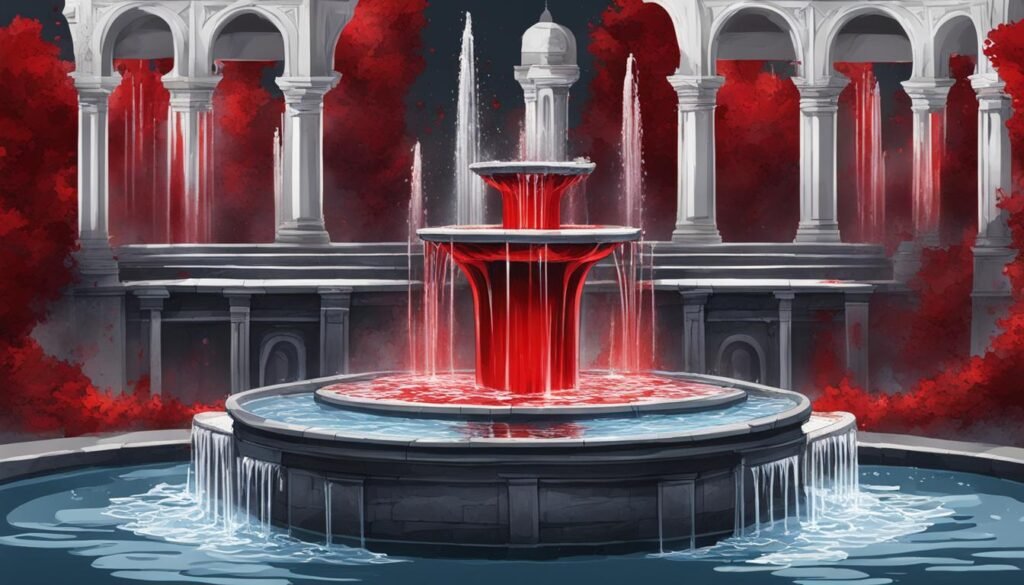In the Gospel of John, there is a unique account of the crucifixion of Jesus that provides deeper insight into the significance of his sacrifice. According to John 19:31-34, while the other crucified individuals had their legs broken by the Roman soldiers, Jesus’ legs were not broken because he was already dead. Instead, one of the soldiers pierced Jesus’ side with a spear, and from it came out blood and water.
This extraordinary event holds profound symbolism in Christian theology, representing spiritual truths that relate to redemption and life. Understanding the symbolism behind the blood and water from Jesus’ side allows believers to grasp the depth of his sacrifice and the transformative power it holds.
Key Takeaways:
- The blood and water that flowed from Jesus’ side hold deep symbolism in Christian theology.
- The blood represents the redemptive aspect of Jesus’ death, offering forgiveness and cleansing of sins.
- The water symbolizes the life-imparting aspect of Jesus’ death, enabling believers to receive eternal life and spiritual growth.
- The piercing of Jesus’ side fulfills Old Testament prophecies, highlighting the significance of his sacrifice.
- The blood and water serve as reminders of God’s love and the transformative power of Jesus’ sacrifice.
The Gospel of John’s Emphasis on Life
Each of the four Gospels presents a unique perspective on the life and ministry of Jesus. In the Gospel of John, there is a distinctive emphasis on the theme of life. John includes specific details about the piercing of Jesus’ side that serve to convey profound spiritual realities and help readers understand the significance behind the blood and water.
The Gospel of John highlights Jesus as the giver and sustainer of life, both physically and spiritually. John 1:4 declares, “In him was life, and the life was the light of men.” Throughout the Gospel, Jesus is depicted as the source of abundant and eternal life for all who believe in him.
“For God so loved the world, that he gave his only Son, that whoever believes in him should not perish but have eternal life.” (John 3:16)
In John’s account of the crucifixion, he records the piercing of Jesus’ side as a significant event. John 19:34 states, “But one of the soldiers pierced his side with a spear, and at once there came out blood and water.” This detail holds deep spiritual symbolism and underscores the Gospel’s emphasis on the life-giving power of Jesus’ sacrifice.
By including the details of the blood and water flowing from Jesus’ side, John intends to lead readers to a deeper understanding of the spiritual realities at play. The blood represents the sacrificial atonement made by Jesus, shedding his blood for the forgiveness of sins. The water symbolizes the spiritual cleansing and refreshment offered through Jesus’ death, providing newness of life and a restored relationship with God.
The Gospel of John’s emphasis on life extends beyond physical existence and encompasses the spiritual life found in Christ. It is through faith in Jesus that individuals can experience abundant life in the present and eternal life in the future.
The Significance of Jesus’ Words
Throughout the Gospel of John, Jesus often speaks about the transformative power of believing in him and receiving the gift of eternal life. His teachings reinforce the Gospel’s emphasis on life and illuminate the spiritual realities that the blood and water from his side represent.
- “I am the bread of life; whoever comes to me shall not hunger, and whoever believes in me shall never thirst.” (John 6:35)
- “…Whoever believes in me, though he die, yet shall he live, and everyone who lives and believes in me shall never die.” (John 11:25-26)
- “I came that they may have life and have it abundantly.” (John 10:10)
These words of Jesus further reinforce the Gospel’s message that true life, both now and for eternity, is found in him. The piercing of Jesus’ side and the subsequent flow of blood and water serve as tangible reminders of this profound truth.
The Gospel of John’s emphasis on life highlights the transformative power of Jesus’ death and resurrection. It invites readers to enter into a personal relationship with Jesus and experience the fullness of life that he offers. Through faith in him, individuals can find forgiveness, redemption, and eternal life.
The Redemptive Aspect of Jesus’ Death
The blood that came out of Jesus’ side symbolizes the redemptive aspect of his death. It is through the shedding of his blood that Jesus accomplished a marvelous redemption, offering forgiveness and cleansing of sins to all who believe in him.
“For even the Son of Man did not come to be served, but to serve, and to give his life as a ransom for many.” – Mark 10:45
The redemptive aspect of Jesus’ death is a core principle in Christian theology. The concept of redemption is deeply rooted in the belief that Jesus willingly gave his life as a ransom to save humanity from the consequences of sin. Through his sacrificial death on the cross, Jesus paid the price for humanity’s sins, offering the opportunity for forgiveness and reconciliation with God.
The shedding of Jesus’ blood carries significant symbolism in the redemptive narrative. Throughout the Bible, blood is often associated with the sacrifice required to atone for sins. In the Old Testament, the shedding of animal blood was necessary for the forgiveness of sins. However, Jesus’ death on the cross served as the ultimate sacrifice, providing complete and permanent redemption for all who believe.
Furthermore, the act of redemption through Jesus’ blood extends beyond mere forgiveness. It encompasses the idea of restoration, renewal, and liberation from the bondage of sin. Through his death, Jesus opened the door to a new life filled with hope, purpose, and eternal salvation.
The significance of the redemptive aspect of Jesus’ death cannot be overstated. It stands as a testament to the boundless love, mercy, and grace of God towards humanity. It invites individuals to experience the transformative power of forgiveness, to be freed from guilt and shame, and to embrace a life of righteousness and spiritual wholeness.
| Key Points |
|---|
| The redemptive aspect of Jesus’ death symbolizes the forgiveness and cleansing of sins. |
| Jesus’ sacrifice served as the ultimate redemption for all who believe. |
| His shed blood carries profound symbolism in the Christian narrative. |
| The redemptive aspect encompasses restoration, renewal, and liberation. |
| Jesus’ death stands as a testament to God’s boundless love and mercy. |
The Life-Imparting Aspect of Jesus’ Death
The water that flowed from Jesus’ side represents the life-imparting aspect of his death. Through his death, Jesus released his divine life, which can now be imparted to all who believe in him. This divine life is what enables believers to receive eternal life and become part of the church.
The significance of the water flowing from Jesus’ side goes beyond mere symbolism. It signifies the outpouring of his life-giving spirit that brings spiritual renewal and transformation to those who accept his sacrifice.
“Whoever believes in me, as Scripture has said, rivers of living water will flow from within them.”
– John 7:38
The water serves as a powerful reminder that through faith in Jesus, believers can experience a new birth and receive the indwelling presence of the Holy Spirit. Just as physical water sustains and nourishes life, the spiritual water flowing from Jesus’ side imparts spiritual life and nourishes the souls of believers.
This life-imparting aspect of Jesus’ death has profound implications for believers. It means that through Jesus, they have access to a source of everlasting life that transcends temporal existence. This divine life empowers them to live in accordance with God’s purposes and experience spiritual growth and fulfillment.
The imagery of the water flowing from Jesus’ side also highlights the transformative nature of his death. Just as water has the power to cleanse and purify, so too does Jesus’ death have the power to cleanse believers from sin and bring about a spiritual rebirth.
Ultimately, the life-imparting aspect of Jesus’ death invites believers into a deep and intimate relationship with him. By receiving his divine life, believers are united with Christ and become partakers of his divine nature.
The Life-Imparting Aspect Illustrated
To illustrate the life-imparting aspect of Jesus’ death, consider the following table:
| Aspect | Description |
|---|---|
| New Birth | Believers are born again through faith in Jesus, receiving new spiritual life. |
| Spiritual Nourishment | Jesus’ divine life sustains and nourishes believers, providing spiritual growth and fulfillment. |
| Transformation | Through Jesus’ death, believers are cleansed and renewed, experiencing a transformation of heart and mind. |
| Eternal Life | Believers have access to a source of everlasting life through their union with Jesus. |
As depicted in the table, the life-imparting aspect of Jesus’ death encompasses various spiritual realities that believers can experience in their journey of faith.
Prophetic Fulfillment
The blood and water that flowed from Jesus’ side also fulfill Old Testament prophecies, pointing to the significance and fulfillment of his sacrifice on the cross. The Gospel of John references two specific prophecies that find their fulfillment in this event.
“Not one of his bones will be broken”
This prophecy from Exodus 12:46 foreshadowed Jesus’ unbroken bones during his crucifixion. In accordance with this prophecy, the Roman soldiers did not break Jesus’ legs, highlighting the divine orchestration of events and reinforcing the prophetic fulfillment in his death.
“They will look on me, the one they have pierced”
Zechariah 12:10 prophesied the piercing of the Messiah, which finds its fulfillment in the moment when Jesus’ side was pierced by a soldier’s spear. This piercing signifies the sacrifice of Jesus and emphasizes the redemptive nature of his death.
By incorporating these prophecies, the Gospel of John not only reveals the fulfillment of Old Testament scriptures but also solidifies the prophetic significance of Jesus’ sacrifice on the cross. This profound fulfillment underscores the divine plan of redemption and highlights Jesus’ role as the promised Messiah.

| Prophecy | Fulfillment |
|---|---|
| Exodus 12:46 | Jesus’ bones remain unbroken during crucifixion |
| Zechariah 12:10 | Jesus’ side is pierced with a spear |
Significance of Hypovolemic Shock
During Jesus’ flogging and subsequent crucifixion, he endured immense physical trauma that caused him to experience hypovolemic shock. This condition, characterized by low blood volume, played a significant role in the events that followed.
As Jesus hung on the cross, the combination of his injuries and the effects of hypovolemic shock led to the flow of both blood and water from his side when it was pierced. This phenomenon holds great significance in understanding the reality of his human death and the fulfillment of prophecies.
It is essential to comprehend the critical role played by hypovolemic shock in Jesus’ crucifixion. This condition arises when there is a significant loss of blood, leading to a drop in blood volume. As a result, the body’s ability to circulate oxygen and nutrients is severely compromised.
In Jesus’ case, the extensive flogging he endured prior to the crucifixion would have contributed to the loss of blood volume. Furthermore, the crucifixion itself, with the nails driven through his hands and feet, further depleted his blood supply. These physical traumas, combined with the effects of hypovolemic shock, created the conditions for the flow of blood and water from his side.
This occurrence aligns with Old Testament prophecies that were fulfilled through Jesus’ crucifixion. In Psalm 22:14, it is foretold, “I am poured out like water, and all my bones are out of joint; my heart is like wax; it is melted within my breast.” This poetic description encapsulates the physical reality of Jesus’ suffering, including the flow of water-like liquid from his side.
“He drinks up curses like water. He drinks them down like wine swallowed by thirst-crazed drinkers.” – Psalm 109:18 (VOICE)
This divine fulfillment of prophecies underscores the significance of Jesus’ sacrifice on the cross. It serves as a powerful reminder of the depth of his love and the lengths to which he went to bring salvation to humanity.
Medical Significance of Hypovolemic Shock
From a medical standpoint, hypovolemic shock is a severe condition that requires urgent medical intervention. It is associated with dangerous drops in blood pressure, diminished organ perfusion, and potentially life-threatening complications.
Understanding the significance of hypovolemic shock in Jesus’ crucifixion deepens our appreciation for the physical toll he underwent during his journey to the cross. It serves as a poignant reminder of the sacrifice he made for humanity’s redemption.
The Dual Fountains of Redemption and Life
The blood and water that came from Jesus’ side opened two fountains for humanity’s needs. The blood symbolizes the fountain for the washing away of sins, providing redemption and forgiveness. The water represents the fountain of life, offering the divine life of Jesus to all believers for spiritual growth and sustenance.
In the Gospel of John, the piercing of Jesus’ side and the flowing of blood and water hold deep spiritual significance. The blood, as a fountain for redemption, signifies the cleansing and forgiveness of sins that Jesus’ sacrificial death offers to humanity. It symbolizes the power of Jesus’ atonement, restoring a broken relationship between God and humanity.
The water, as the fountain of life, represents the life-giving power of Jesus’ death. Just as physical water sustains and nourishes our bodies, the water from Jesus’ side imparts eternal life to those who believe in Him. It signifies the divine life that Jesus provides, enabling believers to experience spiritual growth, transformation, and an intimate relationship with God.
These dual fountains of redemption and life demonstrate the completeness and sufficiency of Jesus’ sacrifice on the cross. Through His shed blood, all sins can be washed away, and through His divine life, believers can receive the abundant and eternal life that He offers.
| Symbol | Meaning |
|---|---|
| Blood | Redemption and forgiveness of sins |
| Water | Divine life and spiritual growth |

In the Gospel of John, Jesus said, “Whoever drinks of the water that I will give him will never be thirsty again. The water that I will give him will become in him a spring of water welling up to eternal life” (John 4:14). This emphasizes the life-giving nature of the water that flows from Jesus, providing sustenance and eternal satisfaction to all who believe in Him.
The Spiritual Lessons of the Blood and Water
The blood and water that flowed from Jesus’ side hold profound spiritual lessons for believers. These symbolic elements serve as reminders of the depth of Jesus’ sacrifice and the forgiveness of sins that it brings.
The blood represents the ultimate act of sacrificial love. As believers reflect upon the blood that flowed from Jesus’ side, they are confronted with the gravity of their own sinfulness and the immense price that was paid for their redemption. It is a call to humility, repentance, and gratitude for the immeasurable mercy extended through Jesus’ death on the cross.
The water, on the other hand, symbolizes the life-giving power of Jesus’ death. Just as water is essential for physical survival, the water that flowed from Jesus’ side signifies the spiritual sustenance and eternal life that believers receive through their union with Him. It is an invitation to drink deeply of the living water that springs forth from Jesus, allowing it to quench their spiritual thirst and bring transformation to their lives.
In John 7:37-38, Jesus Himself said, “If anyone thirsts, let him come to me and drink. Whoever believes in me, as the Scripture has said, ‘Out of his heart will flow rivers of living water.'”
By contemplating the blood and water, believers are called to deeper faith and commitment. They are encouraged to embrace the fullness of Jesus’ sacrifice and allow it to permeate every aspect of their lives. It is an invitation to surrender their old selves and be renewed by the life-giving power of the Holy Spirit, experiencing true spiritual transformation.
Ultimately, the blood and water from Jesus’ side serve as a constant reminder of the spiritual lessons that believers must continually embrace. It is through the recognition of the depth of Jesus’ sacrifice and the life-giving power of His death that believers can walk in the fullness of their salvation, drawing closer to God and experiencing spiritual growth and renewal.
The Fulfilled Scriptures and Indispensable Cross
The piercing of Jesus’ side, along with the flow of blood and water, serves as a profound fulfillment of specific Scriptures and emphasizes the indispensable role of the cross in God’s plan of redemption.
These events stand as testament to the divine orchestration of Jesus’ death, where every detail was intricately designed to bring about humanity’s salvation.
The Scriptures prophesied the Messiah’s crucifixion and the significance of his sacrifice for the forgiveness of sins. Through the piercing of Jesus’ side, these prophecies were fulfilled, solidifying the divine purpose behind his death.
“They will look on me, the one they have pierced, and they will mourn for him as one mourns for an only child, and grieve bitterly for him as one grieves for a firstborn son.” – Zechariah 12:10
| Scripture | Prophecy | Fulfillment |
|---|---|---|
| Exodus 12:46 | No bones shall be broken | Jesus’ bones remained unbroken |
| Zechariah 12:10 | The piercing of the Messiah | Jesus was pierced in his side |
The piercing of Jesus’ side and the resulting flow of blood and water clearly establish the significance of the cross in God’s plan. It was through the sacrificial death of Jesus on the cross that salvation and forgiveness of sins became available to all who believe in him.
Furthermore, the image of Jesus on the cross acts as a powerful symbol of God’s love and mercy. It serves as a reminder of the immense cost paid for humanity’s redemption and the depth of God’s compassion.
As believers contemplate the fulfilled scriptures and the indispensable cross, they are invited to reflect on the magnitude of Jesus’ sacrifice and the eternal impact it has on their lives.

Key Takeaways:
- The piercing of Jesus’ side fulfilled specific Scriptures and underscored the significance of the cross in God’s plan of redemption.
- Prophecies from the Old Testament found their fulfillment in the details of Jesus’ crucifixion, confirming the divine purpose behind his death.
- The flow of blood and water from Jesus’ side serves as a powerful symbol of God’s love, mercy, and the forgiveness of sins.
- Contemplating the fulfilled scriptures and the indispensability of the cross leads believers to a deeper appreciation of Jesus’ sacrifice and its transformative impact on their lives.
Conclusion
The blood and water that flowed from Jesus’ side hold deep significance in Christian theology. They symbolize the redemptive aspect of Jesus’ death, offering forgiveness and cleansing of sins. Additionally, the water represents the life-imparting aspect, enabling believers to receive the divine life of Jesus and experience spiritual growth. These events also fulfill Old Testament prophecies, reinforcing the divine orchestration of Jesus’ sacrifice.
Understanding the profound meaning of the blood and water allows believers to grasp the depth of God’s love and appreciate the transformative power of Jesus’ sacrifice. The blood and water are constant reminders of the immense sacrifice Jesus made on the cross, demonstrating his unfathomable love for humanity.
As believers reflect on the significance of the blood and water, they are reminded of the complete forgiveness and new life found in Jesus. It is through these dual fountains of redemption and life that believers can experience spiritual renewal, transformation, and eternal salvation.
In conclusion, the blood and water that flowed from Jesus’ side serve as enduring symbols of the redemptive and life-imparting significance of his death. They fulfill prophecies, highlight the indispensable role of the cross, and remind believers of the profound sacrifice Jesus made for their salvation. By understanding and embracing the meaning of the blood and water, believers can experience the depth of God’s love and the transformative power of Jesus’ sacrifice in their lives.
FAQ
What does the blood and water from Jesus’ side symbolize?
The blood symbolizes the redemptive aspect of Jesus’ death, offering forgiveness and cleansing of sins. The water represents the life-imparting aspect of his death, enabling believers to receive eternal life and become part of the church.
What is the emphasis of the Gospel of John on life?
The Gospel of John focuses on the theme of life, and the details about the piercing of Jesus’ side in John’s account are meant to convey spiritual realities and help readers understand the profound meaning behind the blood and water.
How does Jesus’ death have a redemptive aspect?
Through the shedding of his blood, Jesus accomplished a marvelous redemption, offering forgiveness and cleansing of sins to all who believe in him.
What is the life-imparting aspect of Jesus’ death?
Through his death, Jesus released his divine life, which can now be imparted to all who believe in him. This divine life enables believers to receive eternal life and become part of the church.
In what way do the blood and water from Jesus’ side fulfill Old Testament prophecies?
The reference to not breaking any of Jesus’ bones echoes the prophecy in Exodus 12:46, while the mention of piercing relates to the prophecy in Zechariah 12:10. These prophecies highlight the significance and fulfillment of Jesus’ sacrifice on the cross.
What is the significance of hypovolemic shock in relation to Jesus’ crucifixion?
Jesus’ flogging and crucifixion caused him to experience hypovolemic shock, a condition characterized by low blood volume. This condition, along with the physical trauma, resulted in the flow of blood and water from his side when it was pierced, emphasizing the reality of his human death and the fulfillment of prophecies.
What do the blood and water from Jesus’ side represent?
The blood symbolizes the fountain for the washing away of sins, providing redemption and forgiveness. The water represents the fountain of life, offering the divine life of Jesus to all believers for spiritual growth and sustenance.
What spiritual lessons can be learned from the blood and water?
The blood reminds believers of the depth of Jesus’ sacrifice and the forgiveness of sins it brings. The water symbolizes the life-giving power of Jesus’ death, enabling believers to receive and experience the divine life in a personal and transformative way.
How do the blood and water relate to fulfilled Scriptures and the indispensable cross?
The piercing of Jesus’ side, along with the flow of blood and water, fulfilled specific Scriptures and underscored the indispensable role of the cross in God’s plan of redemption. These events highlight the divine orchestration of Jesus’ death and establish the significance of his sacrifice for humanity’s salvation.
What is the significance of the blood and water from Jesus’ side?
The blood and water that flowed from Jesus’ side hold deep symbolism in Christian theology. They represent the redemptive and life-imparting aspects of Jesus’ death, fulfill Old Testament prophecies, and serve as reminders of the profound sacrifice Jesus made on the cross.
Source Links
- https://www.gotquestions.org/blood-water-Jesus.html
- https://blog.biblesforamerica.org/what-does-the-blood-and-water-that-came-out-of-jesus-pierced-side-mean/
- https://www.compellingtruth.org/blood-water-Jesus.html

I’m Benjamin, a passionate spiritual seeker and creator of Verses and Prayers. Alongside my girlfriend Emma and our pet lizard Mulle, I cherish family life, enjoy exploring new places, and am deeply involved in my church community. My love for reading and singing biblical verses inspires every aspect of my journey.

